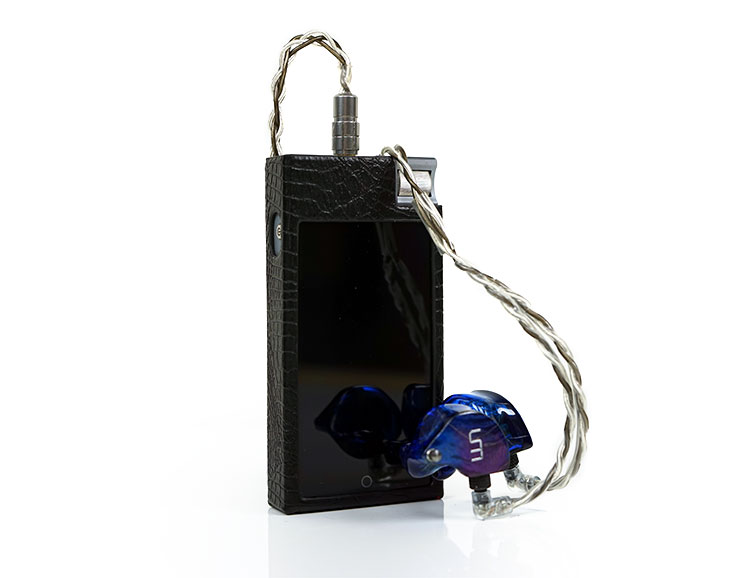Sound Impressions
Summary
The N5ii has a neutral to natural tonal bias with a clean and clear presentation and excellent detail for a DAP at this price point.
Personally, I think Cayin has nailed it with the switch to the ES9018K2m and the better amping design of the N5ii. It is oh so quiet with a superb black background and delivers a very dynamic and involving experience without ever being too ‘in your face’.
It is possibly one of the most mature-sounding ES9018K2m implementations I have heard on a portable device to date.
They have still retained a strong level of musicality at the heart of the N5ii signature but have gone for a response that I believe is more refined and nuanced than before. This is by no means a sterile analytical experience and most certainly there is no “glare”.
Unlike the i5, the N5ii is not as aggressive and far more coherent sounding for my tastes. The i5 was brilliant for its aggressive “fun” sounding low-end and slightly elevated lower treble contrast.
This time the N5ii pitches a more balanced feel to its response and focuses more on individual note quality and tonal refinement across the board. It’s all about the articulation and level of immersion this time.
Bass
The N5ii pulls back on the bass presence a little from the more forward-sounding performance of the i5. There is less physicality in its bass response sounding more linear but with better layering and a level of pace that I consider to be superior to the i5.
That is not to say the low-end of the N5ii is lean, far from it actually, the level of note body is very pleasing. There is just a hint of mid-bass warmth which helps immensely with lower-pitched instrumental timbre’s natural sound and weight.
Mids
Instrumental separation and clarity on the N5ii is the star of the show for me. Demonstrating excellent staging width the mids on the N5ii deliver an excellent level of control particularly with IEMs that excel in imaging, or like the N5ii, have an inherently balanced signature.
Positioning is quite neutral so they are not too far behind vocals but the spaciousness of the N5ii mid-pitched instruments and lack of bass bloom into the mids means they are never lost or muddy sounding.
Synergy with the Noble Audio Savanna, for example, delivered a far more immersive and holographic level of staging than I previously experienced with AK-flavored mid-fi DAPs such as the M3s and even the older i5. That has always been a strength of the ES chip range, that level of dynamic range and transient response is very compelling.
Vocals
I am particularly pleased with how the N5ii gets on top of vocals, especially female breathy vocals, and prevents it from either sounding too digital or sharp sounding. Some older ES9018K2M implementations sounded way too cold for my liking on voicing and synergy was an elusive beast as a result.
Not so with the N5ii. You get a slightly softer attack than the i5 and a more neutral positioning. It is not as forward sounding but it does sound a little less ‘edgy’ and more forgiving. The N5ii really makes a mockery of some of those AK vs Sabre myths, to be honest.
Treble
Treble balance is a little different from the i5 with a more neutral lower treble balance and more sparkle and air in the final octave. Percussion snap is a touch softer on the N5ii but no less accurate, just not as in your face as before. Sibilance is kept to a minimum with this tuning which I just love.
There is zero glare in the N5ii treble also and generally, I find the signature from 4-5k onwards to be very balanced and smoothly delivered. The level of detail is also very good indeed with a strong emphasis on clarity and articulation. Does it have a thick level of body? Possibly not, but just enough to prevent it from coming across as brittle or too ethereal in nature.
Synergy
Noise
Zero noise from my most efficient IEMs including the Andromeda, 64 Audio A18, Vision Ears VE8, and Shure’s SE846. What an excellent performer! The new low gain mode is far more suited to low and medium-efficiency IEMs with no background hiss and a wonderfully black background in pretty much any well-recorded track I threw at the N5ii.
You can, of course, use that old setting as it is now switched to medium gain on the N5ii but guess what? No noise either from the medium gain and just the subtlest of noise levels from the high gain. The only difference in high gain is you can hear the mute relay kick in and that is about it.
This is clearly ahead of the X7ii and X5iii in terms of noise control and background hiss.
Efficiency
Dropping the single-ended output level to 150mW was a good move for efficient IEMs. I now get plenty of micro-voltage control from the analog pot on the N5ii, much more so than the I5.
With the Andromeda in the new low-gain setting, I can get about 10-20 digital steps from low-level listening to blasting levels of sound. The i5 was far more restrictive on its older low gain setting with about 8-10 digital steps and a starting point of almost zero for these types of IEMs.
Impedance Matching
On Point
The output impedance of the N5ii is well under 1Ω at 0.4Ω single-ended and just 0.6Ω for its balanced output. That’s right on the money for me for a modern DAP amping stage for low-impedance gear.
Impedance and Noise
As a point of contrast, the HiBy Music R6 is wonderful as it rocks a 10Ω output, and the smaller Shanling M2s is rated at 4.8Ω.
These higher impedance outputs do make a difference. Often the reason is noise suppression and both do wonderful jobs in low noise performance. How much better then is the n5ii with low impedance and low noise? For those not willing to invest in an impedance adapter I would say a lot.
Testing Confirmed
Testing the N5ii with the iFi IEMatch (allowing for attenuation in gain) and Custom Art’s FIBAE 1 IEM I found the signal to be very consistent in terms of tonal bias with no skewed impedance-affected response.
If you know your IEM’s tonal signature well the N5ii will reproduce it faithfully. The only differences will be the dynamics and staging power of the balanced output and the N5ii’s own tonal flavor which is buttery smooth and very detailed.
Select Comparisons
FiiO X5 Mark III
$399
Form Factor
Physically they are both excellent in terms of form factor. The N5ii is a little more compact and not as wide as the X5iii. Some might find that additional screen real estate more useful and easier to work with.
Both have the same Dpi though at 240 dpi so there is no discernable difference in numbers but the N5ii theme color and glass protector do reduce visibility for me.
Software
Both use Android 5.1, and both use a Rockchip RK3188 implementation but there are some significant differences in how they are set up.
Our Antutu results had a marginal difference in favor of the N5ii, however, the 13% difference in RAM performance had me wondering what quality of RAM was in the X5iii or how it was being utilized on their OS platform.
The X5iii is a more open flavor of Android than the N5ii. You can dual boot in their pure player to get a similar effect to the N5ii’s audio priority mode but I think the N5ii solution is more refined. You do not need to reboot the N5ii to get the same effect.
Power
Both have a balanced and unbalanced output, however, the N5ii’s balanced and unbalanced output is better designed with a greater differential between efficiency and power. The X5iii balanced output was a bit underpowered, even more so than the unbalanced and more of a cosmetic enhancement.
True, the turbo boost in the last firmware does increase its potential but the level of noise is much higher even in its single-ended output. At 150mW output power with more levels of gain options, the N5ii is the savvier choice for efficient IEMs.
Sound
Tonally both are aiming for a similar presentation, a natural to warm sound with a slightly relaxed delivery. There are however some nuanced differences that give the N5ii a slight edge.
The first is the slightly better mid-bass and lower mids instrumental body on the N5ii. The X5iii just sounds a little dipped and cooler in this region with a slightly thinner sounding instrumental timbre as a result.
The second is the vocal presence. The N5ii has a bit more body and a slightly smoother attack. Combined with the excellent instrumental separation and staging width the N5ii has a slightly more engaging mids presentation.
The X5iii is not quite as controlled or defined with a slightly slower transient response. The noise levels are higher also so the blacker background of the N5ii does help in that regard.
The final difference is the treble response, particularly the lower treble performance. The N5ii performance is again a little smoother and more balanced sounding. The X5iii has a slightly harder attack and a bit more lower treble energy. The N5ii has more treble sparkle and an airy final octave.
HiBy Music R6
$649 SS, $569 Aluminum edition
Form Factor
The R6 comes in two flavors, Aluminum or stainless steel (SS). Both, however, have the same form factor with approximately the same length as the N5ii but a little wider.
Like the X5iii the width may be preferred for ease of navigation around the OS. It is also much heavier in SS form than the N5ii by over 100g, though the 190g of the aluminum version does cut some of that weight out.
Software
I can’t deny it the R6 is the fastest DAP in the market today and perhaps the most modern implementation of Android yet to be seen on a music player. Its Snapdragon processor and 3GB of RAM on an open Android 6.0 interface combined with HiBy’s OS app make it an absolute pleasure to use.
The Antutu numbers do not lie, everything pales in terms of operational performance. Even its version of audio priority mode, DTA architecture is much more fundamental for bypassing every single app you put on it.
The DAC implementation is dual ES9028Q2M which is more modern than the N5ii and probably a lot more expensive to procure hence the higher price.
Power
The only issue with the R6 is the amp choice with its 10Ω output impedance. Noise is on par with the N5ii but the N5ii’s sub-1Ω output impedance on both balanced and unbalanced gives it a competitive edge.
You will need a resistance adapter such as an IEMatch for the R6 to use with sensitive IEMs. No so for the N5ii which plays true to whatever you plug into it.
Sound
Both have some shared commonalities with their performance. Both have a smooth to natural sounding tonality, however this time it is the R6 that has the better body and smoother treble response compared to the N5ii which has a touch more focus on the mids and treble performance.
The use of the dual ES9028PRO brings in some of these new-generation characteristics that I have been a big fan of for most of last year.
The new PRO series dynamic range is immense whilst, at the same time, the treble sparkle that sometimes comes across in lesser implementations has yet to raise its ugly head on any 9028/9038 implementation. And that is the case of the R6.
The N5ii just sounds slightly leaner, especially on the low-end whereas the R6 is much beefier and more physical sounding. That fullness creeps into the lower mids also with a richer thicker instrumental timbre whereas the N5ii stays a bit more neutral though still with a good body.
The N5ii upper mids and treble though are further forward sounding with a bit more odd-harmonic bias but not by a huge amount. You get an ever so slightly harder attack on the N5ii compared to the R6.
This is not an overly forward treble more of a case of the R6 being tuned to sound a little more relaxed and the N5ii staying relatively neutral in the lower treble.
Shanling M3s
$279
Form Factor
Props to Shanling for the form factor of the M3s. It’s beautifully designed, smooth, and lithe in appearance. It pretty much makes most mid-fi DAPs look boxy in contrast and certainly smaller in the hand than the N5ii.
Screen
The problem begins though when you turn it on and you get the M2s-like screen and a black slab of nothing below it. The M2s screen was dominant, this feels half-finished. The 2.5D glass finish over the front though is beautiful and the DPI of the IPS screen is higher at 300 compared to the 240 of the N5ii.
Software
Software wise this is a non-touch HiBy classic SOC setup. It’s quick, and painless but much more limited than the N5ii in terms of zero apps and no WiFi. The non-touch UI is also less easy to use and more time-consuming. It does, however, use an aptX capable BT receiver and HiBy Link which does give it an edge over the N5ii for BT capability.
Hardware & Power
The M3s is an AK-infused implementation using dual AK4490 chipset implementation though only two oscillators instead of the 3 deployed by N5ii.
Like the N5ii the M3s has both balanced and unbalanced output as well as USB-C connectivity. It is also an excellent performer for noise with a useful spread of power comparable to the N5ii at 150mW unbalanced and 230mW balanced.
Sound
Like the N5ii, the M3s delivers a clean and very smooth presentation with a somewhat linear but mildly warm bass response and an airy top end with good sparkle. Side by side you could call the M3s the brighter of the two with a lower treble performance that is a little further forward.
The key differences are in how much body the N5ii delivers in its instrumental pitch as well as its ability to convey better instrumental separation and a more controlled transient response.
The M3s is a bit more standoff and diffuse in its presentation delivering a low-end that is not only linear but rolls off a little bit more than the N5ii. The N5ii low-end has more warmth, sounds a bit fuller, and has better sub-bass presence. The N5ii also sounds a bit more spacious and delivers a bit more punch in its mid-bass.
Instrumental timbre is a little more natural and richer sounding than the M3s which tends to sound more neutral.
Both have a smooth vocal delivery, I cannot fault the M3s in that respect, though I do detect a slightly greater emphasis on upper-order harmonics that tend to just emphasize a harder edge. As such vocals can have a slight zing in them as does percussion and high-pitched synth work.
Our Verdict
I stated that the X5iii was the benchmark for mid-fi DAPs in Feb 2017. Standing by that assessment is easy after hearing the N5ii because anything that gets a thumbs-up in my book has to beat that benchmark. The N5ii gets a thumbs-up in a lot of areas.
I am delighted with how the N5ii sound quality turned out in all honesty. I think Cayin has a winner on their hands for audio performance. It does not sound like a typical Sabre DAC implementation at all, at least not compared to its price peers or direct competitors.
It is only when you pitch it up against the HiBy Music R6 do you get any inkling that it is a Sabre DAC. Cayin just made a monkey out of the myth that Sabre DACs have to sound bright or analytical with the N5ii tuning.
What is missing? Well, I have nothing much to say about the BT implementation. WiFi is your only real connection with the outside world of value.
The RK3188 CPU is really pushed to the limit in some cases with that 1GB of RAM. Be careful about streaming really resource-intensive sample rates or heavy-duty apps, they might gum up the works and crash the N5ii. And the screen’s legibility is a little disappointing also.
Apart from those, I can safely say that the N5ii is a very good performer. It nestles nicely with the DX200, the R6, and the X7ii as my favored picks for DAPs under $1000 and beats out a lot of similarly priced mid-fi DAPs. What a nice way to start 2018.
Cayin N5ii Specifications
PHONES OUT (SINGLE-ENDED)
- Power rating: 150mW+150mW (@32Ω)
- Frequency Response: 20-20kHz (±0.2dB, Fs=192kHz) 5-50kHz (±1dB, Fs=192kHz)
- THD+N: 0.002% (1kHz, Fs=44.1kHz;20Hz-20kHz, A-Weighted)
- Dynamic Range: 116dB (20Hz-20kHz, A-Weighted)
- SNR: 116dB (20Hz-20kHz, A-Weighted)
- Channel Separation: 76dB Output Impedance: ≤0.4Ω Connector: 3.5mm TRS (shared with Line Out)
PHONES OUT (BALANCED)
- Power rating: 250mW+250mW (@32Ω)
- Frequency Response: 20-20kHz (±0.2dB, Fs=192kHz) 5-50kHz (±1dB, Fs=192kHz)
- THD+N: 0.002% (1kHz, Fs=44.1kHz;20Hz-20kHz, A-Weighted)
- Dynamic Range: 117dB (20Hz-20kHz, A-Weighted)
- SNR: 117dB (20Hz-20kHz, A-Weighted)
- Channel Separation: 92dB
- Output Impedance: ≤0.6Ω
- Connector: 2.5mm TRRS
LINE OUT
- Output Level: 2.0V (@10kΩ)
- Frequency Response: 20-20kHz (±0.2dB, Fs=192kHz) 5-50kHz (±1dB, Fs=192kHz)
- THD+N: 0.003% (1kHz, Fs=44.1kHz;20Hz-20kHz, A-Weighted)
- Dynamic Range: 116dB (20Hz-20kHz, A-Weighted)
- SNR: 116dB (20Hz-20kHz, A-Weighted)
- Channel Separation: 92dB
- Imp. matching: ≥10kΩ (suggested)
- Connector: 3.5mm TRS (shared with Phone Out)
USB AUDIO OUTPUT
- DSD Mode: DSD64/DSD128, DoP or D2P*
- PCM Mode: Upto 24Bit/384kHz
S/PDIF OUTPUT
- DSD Mode: DSD64, DoP or D2P*
- PCM Mode: Upto 24Bit/192kHz convert higher resolution to 176.4kHz or 192kHz
Recommended Headphone: impedance Range 16~200Ω (recommended)
*D2P: DSD to PCM, always output at 24bit/88.2kHz
PRODUCT HIGHLIGHTS
- MCU: Rockchip RK3188
- Display: 3.65” 845×480 TFT touch screen
- DAC: ESS9018K2M
- Op-Amp: OPA1622 x 3
- Storage: 32GB + TF (upto 256GBx2)
- Headphone: 3.5mm + 2.5mm (Balanced)
- Line: 3.5mm (shared)
- Digital: Coaxial, USB Audio (in/out)
- USB: Type C (2.0), charging, OTG
- System: Custom Android 5.1
- RAM: 1G DDR3
- Wi-Fi: 802.11 b/g/n 2.4GHz
- Bluetooth: BT4.0
- Battery: 3000mAH
- Duration: ~12 hours
- Charging: ~3 hours (2.1A)
- Dimension: 115*57*15.3 (mm)
- Weight: ~150g







